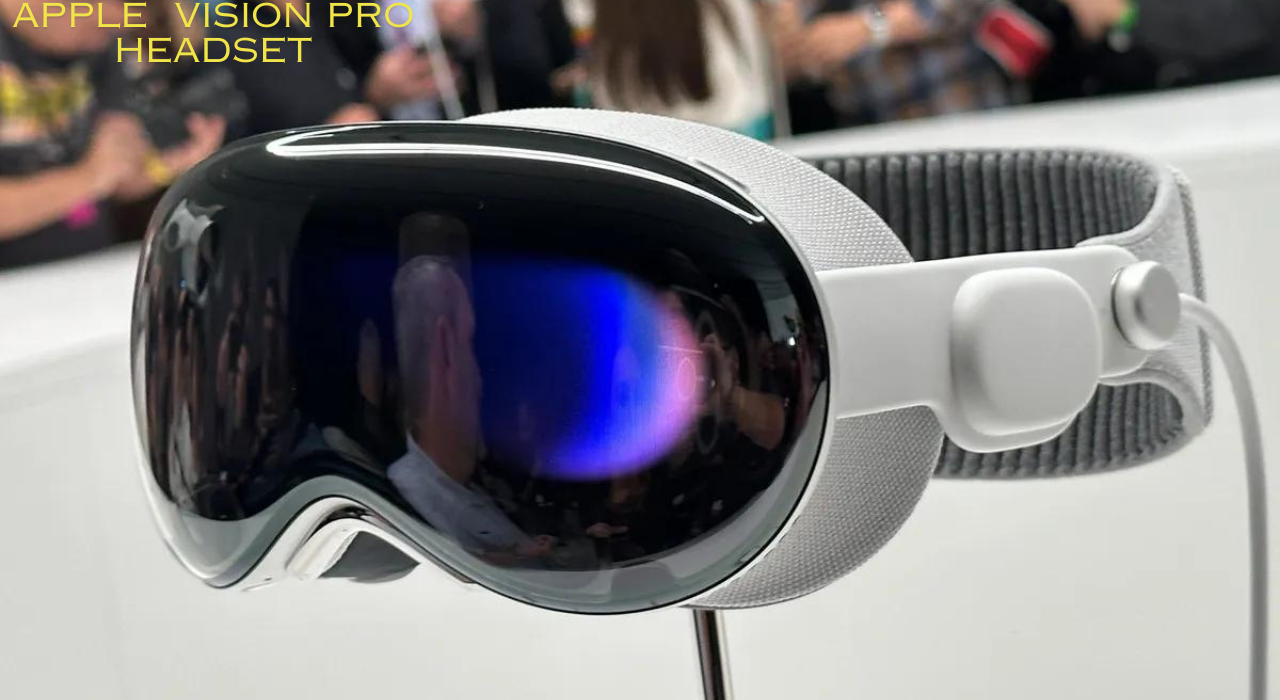Apple’s debut into the mixed reality arena comes in the form of the Apple Vision Pro, and we’ve got the lowdown before it hits the shelves at your nearest Apple Store.
Let’s start by clarifying what we mean when we say mixed reality – it’s not just about immersing yourself in a virtual world. The Apple Vision Pro, although it may look like a top-tier VR headset, goes beyond that. With features like EyeSight and Digital Persona, it ensures you stay connected to the real world while still enjoying the perks of mixed reality.
Now, let’s talk about the elephant in the room – the price tag. At a hefty $3,499, the Apple Vision Pro proudly claims the title of the most expensive mainstream headset out there, be it virtual reality or mixed reality. But hey, quality comes at a cost, right? As for the release date, Apple promises it will be available in early 2024, and a quick check of the calendar confirms we’re right on schedule.
Here’s a snapshot of what you can expect from the Apple Vision Pro:
- Priced at $3,499 in the U.S., initially available on February 2, with global availability to follow.
- Twin 4K displays promise stunning HDR picture quality, but glasses wearers might need custom Zeiss inserts.
- Features like EyeSight keep you connected with the physical world, displaying your engagement to others.
- Introducing visionOS for native 3D experiences on the Vision Pro, complemented by an App Store for iOS and iPadOS apps.
- The crown on top lets you control your level of immersion, toggling between augmented and virtual reality.
- Forget controllers – eye and hand tracking, plus voice commands, are the way to go.
- Capture spatial photos and videos with a simple tap, and let EyeSight inform those around you.
- Exciting partnership alert: Disney is on board, crafting exclusive experiences for the Vision Pro, from Disney World adventures to Marvel games.
What the Apple Vision Pro Price Reflects
let’s break down the details about Apple’s Vision Pro – the buzzworthy mixed reality headset that’s creating quite a stir.
First things first, the price tag: $3,499. That’s what it’ll cost you to dive into the world of the Vision Pro, but keep in mind, initially, it’s a U.S.-only affair. Sorry, global friends – no pricing details for you just yet.
Now, what’s in the box for that $3,499 investment? Well, you’re getting a device loaded with 256GB of storage, a battery, a USB-C charging brick and cable, a light seal, 2 light seal cushions, a cover for the front of the headset, and two band options. But if you’re a glasses or contacts wearer, here’s a heads up – you’ll need to snag an extra pair of lenses to make the Vision Pro work for you. Zeiss has you covered with readers at $99 and prescription lenses at $149, both attaching magnetically to the Vision Pro’s interior.
For those eager to be among the first to experience the Vision Pro, pre-orders kick off on January 19 at 8 a.m. EST/5 a.m. PST. If you’ve been patiently waiting, Apple might have sent you a heads-up notification about this exciting event.
Now, onto the rumors – the tech world’s favorite playground. Whispers about the Apple Vision Pro 2 are already making waves. Initially, a leak hinted at a familiar-looking successor, but now the grapevine is abuzz with talk of not one, but possibly four new Vision headset models. Hold on, though – the first-gen Vision Pro hasn’t even hit the shelves yet.
But, what if Apple graces us with a more budget-friendly Vision Pro? That’d be a game-changer. Given the current model’s supply chain constraints, especially with those pricey displays, a more affordable version might drop some of the premium features. Rumor has it that Sony, responsible for the Micro OLED displays, can only churn out 100,000 to 200,000 displays per quarter. That translates to a potential cap of 400,000 headsets per year for Apple.
And here’s the plot twist – a report from the Financial Times suggests that Apple’s initial sales target of 1 million units in the first year has been slashed to 400,000 units. It might make hitting the 20 million user install base in 5 years a bit tricky, according to some analysts. But, hey, Apple’s optimism remains unshaken, with reports indicating a projection of 10 million units sold by 2026.
Apple Vision Pro’s Arrival Date Revealed
The Apple Vision Pro is officially hitting the shelves on February 2, as confirmed by Apple. This announcement comes on the heels of numerous reports speculating an early 2024 launch.
Now, here’s the catch – initially, the Vision Pro is exclusively for our friends in the U.S. But fear not, global enthusiasts, as reports suggest a worldwide rollout in 2025. So, patience is the name of the game.
Once the Vision Pro makes its grand entrance, you won’t be ordering it online – you’ll need to make a pilgrimage to your local Apple store. Tim Cook himself spilled the beans during Apple’s FYQ4 earnings call, mentioning that the Vision Pro will be “in our stores only.” Forget the usual grab-and-go routine; Apple has something different in mind. CEO Tim Cook hinted at a more immersive process with in-store demos to elevate your shopping experience.
So, mark your calendars and make a date with your nearest Apple store on February 2 if you’re eager to lay your hands on the much-anticipated Apple Vision Pro. It’s not just a purchase; it’s a whole experience!
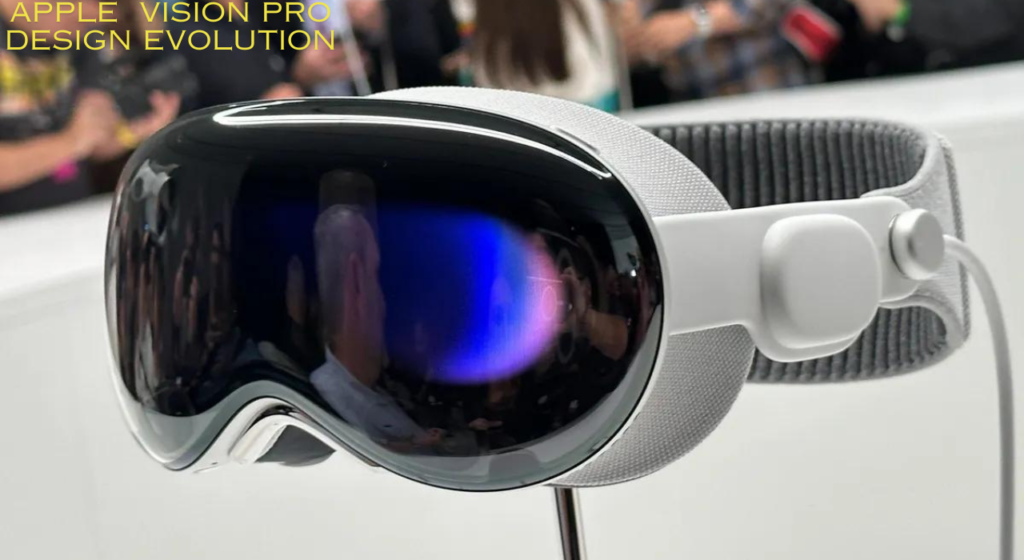
The Design Evolution of Apple Vision Pro
Let’s take a closer look at the Apple Vision Pro – it may seem like your typical VR headset or mixed reality device, but once you power it up, the distinctions become quite apparent.
The standout feature is the front visor, boasting a display beneath a curved pane of 3D laminated glass. This unique setup facilitates EyeSight, a feature that showcases your eyes to those around you, creating a more natural interaction experience. Quick heads-up, though – if EyeSight is a must for you, opt for the first-gen Apple Vision Pro. The future of a cheaper version sans EyeSight is uncertain, but rumors are swirling.
This glass pane isn’t just for show – it doubles as a lens for the Vision Pro’s impressive camera array. Get ready for some numbers – we’re talking 12 cameras and six microphones. Forget controllers; the Vision Pro relies on a combo of eye tracking, hand gestures, and voice commands for control.
Apple’s signature attention to detail extends to the headset’s construction, featuring a custom aluminum alloy frame that curves to fit your face seamlessly. The Light Seal, equivalent to Meta’s facial interface, is modular, offering various shapes and sizes for a tailored fit. Made from soft fabric, it ensures comfort during prolonged use.
Speaking of fit, the Head Band, available in multiple sizes, uses a 3D knitted fabric and a simple locking mechanism for attachment. The “audio pods,” aka speakers, deliver Personalized Spatial Audio, enhancing the immersive experience.
Now, the top of the headset hosts two buttons – an action button for spatial photos and videos and a crown reminiscent of the Apple Watch. The crown allows you to control the immersion level, especially handy when diving into the Vision Pro’s Cinema Environments, simulating a 100-foot screen across 13 locations.
Here’s a crucial design note – the Vision Pro can be your all-day companion when plugged in. However, for cordless adventures, you’ll need the ‘Magic Battery,’ providing about two hours of power. It connects via a woven cable, and yes, you guessed it, it comes with its own Apple charger. Keep an eye out for a USB-C adapter seen in a WWDC developer video – its availability for all users is still up in the air.
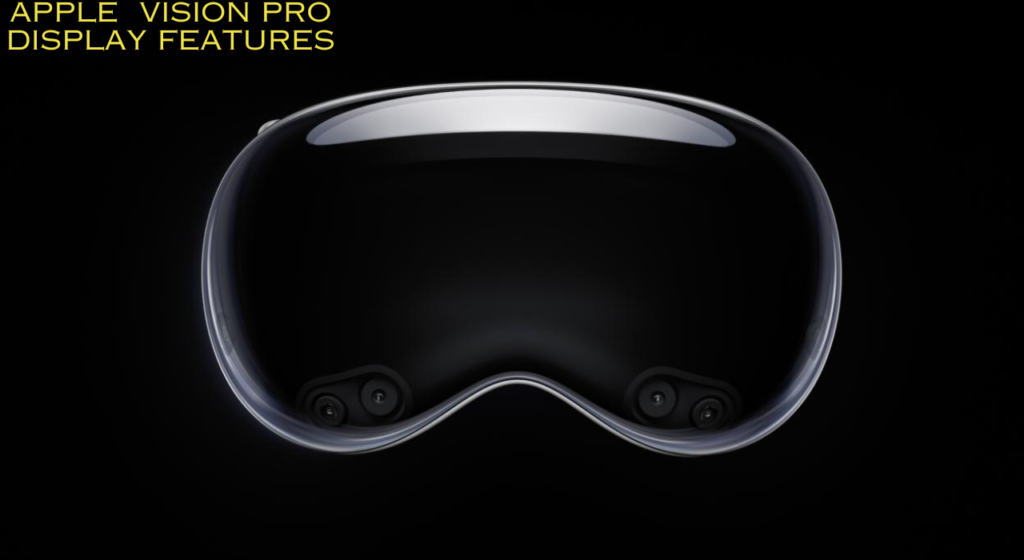
A Deep Dive into the Latest Display Features
Let’s dive into the visual powerhouse that is the Apple Vision Pro – a display that’s making waves, leaving competitors in the dust, especially Meta.
Picture this: Two Micro OLED 4K displays, one for each eye, offering a stunning visual experience. Leaks post-WWDC suggest an eye-watering display resolution of 3800 x 3000 per eye – talk about clarity! Each display, no larger than a postage stamp, packs incredible pixel density. Together, they boast a whopping 23 million pixels, a mind-boggling 64 times the pixel density of an iPhone. It’s a display marvel that puts the Apple Vision Pro ahead of the Meta Quest Pro, at least on paper.
Curious about the Micro OLED technology making this magic happen? Check out our Micro OLED explainer for the inside scoop on how it works, its perks, and drawbacks.
Apple proudly declares that these twin displays support “wide color and high dynamic range.” While the specifics about HDR formats like HDR10 or Dolby Vision are a bit hazy, the new R1 chip from Apple ensures content reaches these displays in just 12 milliseconds. For 2D content, the refresh rate sits at 90Hz, peaking at 96Hz for content created at 24fps.
Now, here’s a bit of a bummer for glasses wearers – the Apple Vision Pro won’t play nice with your frames. Fear not, though; Apple has teamed up with Zeiss to offer optical inserts as a glasses alternative. Readers come at $99, while prescription lenses will set you back $149, in addition to the $3,499 base price. Zeiss has even set up a dedicated site for these inserts, making the transition seamless.
As if that’s not enough, a sneak peek into the future reveals a patent application showcasing a liquid display design. Imagine actuators, pumps, and reservoirs working together to shape and reshape lenses within flexible and/or rigid walls. While this won’t be part of the current Vision Pro edition, it sparks excitement for potential advancements that might eliminate the need for custom inserts down the road.
So, if you’re all about jaw-dropping displays and cutting-edge tech, the Apple Vision Pro is set to redefine your visual experience!
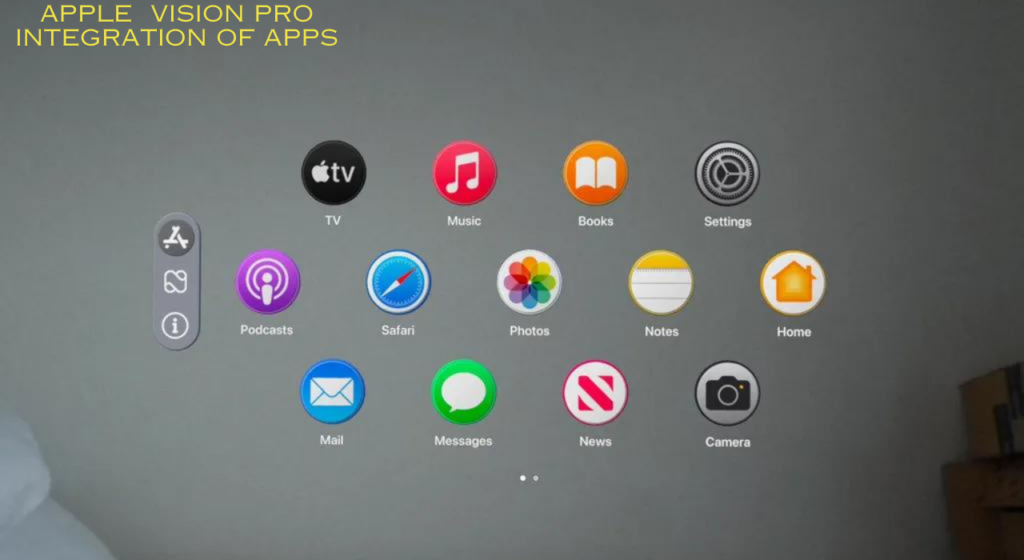
The Integration of Apps in Apple Vision Pro
Let’s unravel the fascinating world of the Apple Vision Pro and its very own operating system, visionOS, introduced alongside it at last year’s WWDC.
First things first, what sets the Vision Pro apart visually? It flaunts two Micro OLED 4K displays, a technological marvel surpassing Meta’s offerings. Each display, the size of a postage stamp, delivers an impressive 3800 x 3000 resolution per eye. This pixel-packed setup, totaling 23 million pixels, outshines the iPhone’s pixel density by a whopping 64 times. It’s a visual spectacle that puts the Vision Pro ahead of the Meta Quest Pro, at least on paper.
Now, visionOS takes center stage, creating a tailored operating system for the Vision Pro. Its standout feature? EyeSight. Picture this: it reveals your eyes to the world or conceals them when immersed in the headset. What’s intriguing is its ability to smoothly transition between the virtual and physical world as someone enters your direct field of view.
Leaked info from an Apple TV Plus show set hints at a camera designed for 180-degree footage, fueling speculation about immersive content tailored for the Vision Pro. Imagine enjoying shows or movies with the headset’s wide field of vision. One potential gem in the lineup could be “Monarch: Legacy of Monsters,” a Godzilla TV series reportedly shot using the rumored 180-degree camera.
The Vision Pro is all about coexisting with your physical space, and visionOS embraces this philosophy. It crafts a 3D user interface that responds to natural light, casting shadows and allowing apps to be manipulated with simple hand gestures.
A nifty “Visual Search” feature is in the works, enabling users to get real-world object information displayed in front of their eyes. They can even copy, paste, and translate the text into 17 languages. The Vision Pro doesn’t skimp on apps – it’s set to come with a variety out of the box. While native visionOS apps are growing, it seamlessly integrates with iOS and iPad OS apps from the App Store.
Gaming enthusiasts, fear not! Apple Arcade offers over 100 games, including NBA 2K, playable on day one. Don’t worry if you prefer a controller; the Vision Pro supports Bluetooth controllers since Apple doesn’t have its own first-party controllers.
Unity’s PolySpatial tool is a game-changer, allowing developers to port or create immersive games for the platform. However, a recent snag could be the install fees Unity announced for games using its engine, potentially causing friction for developers.
Beyond games, the Vision Pro seamlessly integrates typical productivity apps, like Safari and FaceTime. Interestingly, FaceTime generates a Digital Persona to represent you, simulating your face and hand movements. A standout feature lets you expand your Mac display wirelessly into a larger 4K display, aligning with other visionOS apps.
For those jet-setting moments, the visionOS Travel Mode tones down awareness features, optimizing the experience in confined spaces like planes. Another interesting tidbit is Guest Mode, allowing you to lend the headset while safeguarding personal data.
While not confirmed for the current generation, a patented “privacy cloak” feature could be in the works, offering a private space in a “computer-generated reality.”
And there’s a lot more on the horizon – from multiple Mac desktops in the headset to FaceTime with multiple Digital Personas and access to Apple Fitness Plus, these features are planned for the second-generation headset.
To get a glimpse of how visionOS might look, Supernova Technologies managed to showcase it on a Meta Quest Pro. It’s a visual feast, although getting it to work requires some tech savvy.
Lastly, brace yourselves for a tech-enhanced NBA viewing experience, as the league collaborates with Apple for mixed reality games. The Apple Vision Pro is not just a headset; it’s a portal to a world where reality and virtuality seamlessly coexist.
Rumored Specs for Apple’s Innovative Mixed Reality Experience
Let’s unravel the tech brilliance packed into the Apple Vision Pro, revealing the magic both inside and outside the headset.
Starting with the exterior, the Vision Pro is no slouch in the sensory department. It boasts a whopping 12 cameras, six microphones, and five sensors strategically placed for a seamless trifecta of control – eye tracking, hand tracking, and voice commands. The icing on the cake? A ring of LED lights inside the headset that projects invisible patterns onto your eyes, aiding the eye-tracking experience. These clever LED lights also power Optic ID, Apple’s take on Face ID, ensuring top-notch security.
Under the hood, it’s an all-Apple affair. The M2 chip takes the lead, handling the heavy lifting, while a shiny new R1 chip steps in to manage sensor inputs and ensure the display stays lag-free. Apple boasts an impressive 12ms input lag for the twin 4K Micro OLED displays, putting it on par with some of the best TVs on the market.
Now, onto storage – the Vision Pro is set to offer a generous 256GB, giving you ample space for your mixed reality adventures.
Audio takes center stage with spatial magic, thanks to speakers strategically placed on each side of the headset, near the Head Band connection. These audio pods, as Apple calls them, house individually amplified drivers, delivering what they proudly claim is “the most advanced Spatial Audio system ever.” The best part? It’s not just about what’s on paper; these drivers can be fine-tuned to cater to your unique head and ear dimensions, providing a personalized audio experience.
But wait, there’s more to the Vision Pro than just its standalone specs. Apple is all about integration, aiming to seamlessly blend the Vision Pro into its broader device ecosystem. The ultrawide-band chip in the iPhone 15 could get a power-efficient upgrade to a 7nm chip, optimizing its collaboration with the Vision Pro.
In essence, the Apple Vision Pro isn’t just a headset; it’s a symphony of cutting-edge technology, promising an immersive and seamlessly connected experience within the Apple ecosystem. Get ready for a new era of mixed reality adventures!
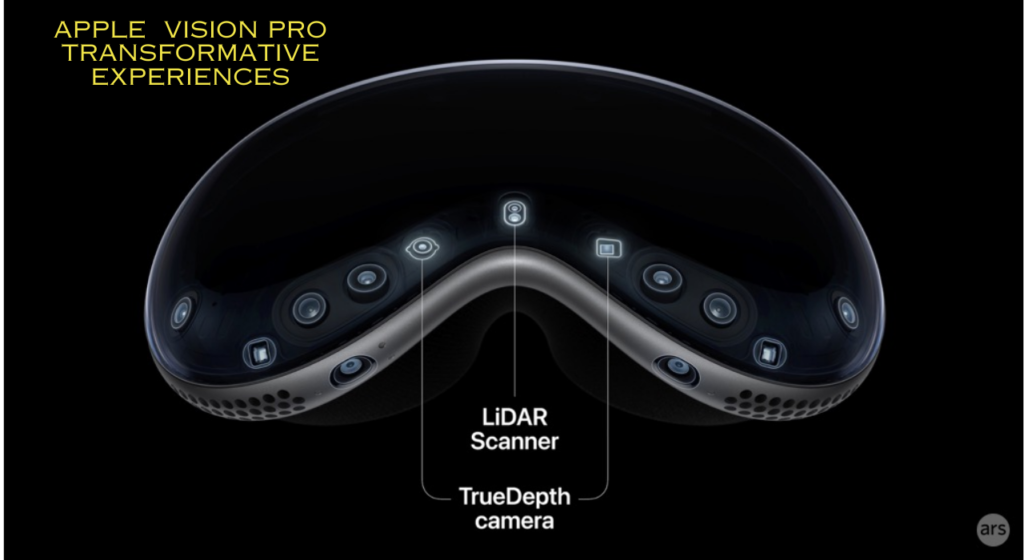
Transformative Experiences with Apple Vision Pro Video
Exciting news for iPhone 15 Pro and iPhone 15 Pro Max users! With the rollout of the iOS 17.2 update in late 2023, a new feature unlocks the potential for recording spatial videos in mesmerizing 3D. While the complete experience awaits the arrival of the Vision Pro headset, users can start capturing immersive 3D moments by toggling on the Spatial Video option (Settings > Camera > Formats > Video Capture).
Here’s the magic behind it: Using the 13mm ultrawide and 48MP main cameras in landscape mode (yes, hold your phone horizontally), your iPhone 15 Pro captures side-by-side videos. When played back on the Vision Pro, these videos transform into your very own VR experience. The latest iOS 17.2 beta update spills the beans, revealing that the recording process involves capturing two 1080p, 30fps videos simultaneously. The lens and distance variations are seamlessly addressed through computational photography.
Now, with iOS 17.2 in action, all proud owners of the latest iPhones can start building a library of personal memories set to come alive in 3D on the Vision Pro. Early adopters who’ve had a sneak peek at their spatial videos on the Apple Vision Pro can’t stop raving about the immersive and magical experience. Get ready to turn your everyday moments into captivating 3D memories!
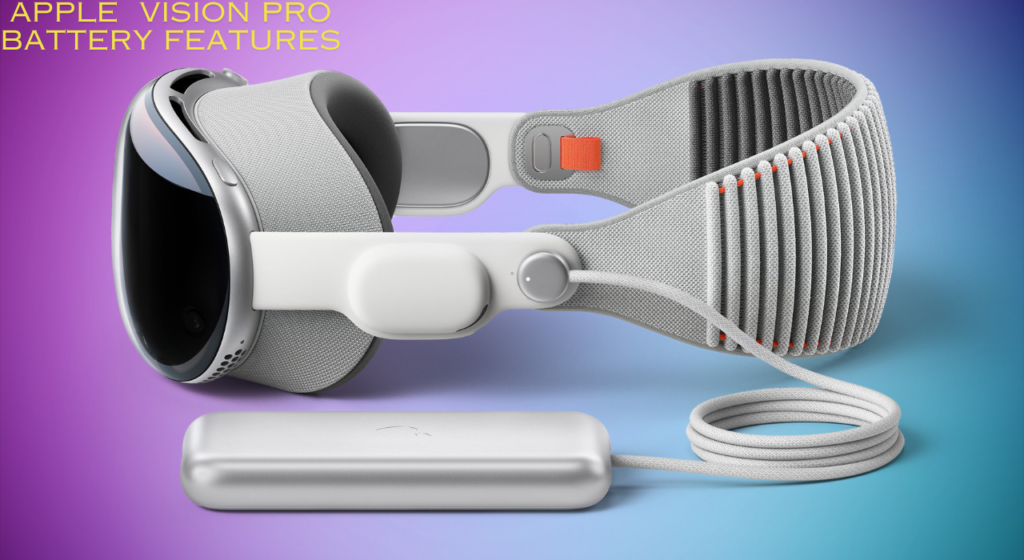
Demystifying the Apple Vision Pro Battery Features
Now, let’s address one of the significant drawbacks of the Apple Vision Pro, and it’s not just about the hefty price tag. Unlike standalone headsets like the Meta Quest 3, which can operate independently or tether to a PC, the Vision Pro requires a connection to function.
But fret not, you do have options. Option one: you can go old-school and plug the headset in, enjoying the Vision Pro all day long. However, there’s a slight catch – Apple hasn’t explicitly mentioned whether this works when connected to a Mac or MacBook. So, for now, it seems like you’ll be tethering straight into the nearest wall.
If that doesn’t quite float your boat, there’s an alternative in the mix. Apple has crafted an external battery pack, potentially named the ‘Magic Battery,’ cleverly attaching around the temple of the headset via a woven cable.
Now, the good news? The battery pack is reportedly slim enough to slide into your pocket, at least according to Apple. And there’s a chance it might come in various sizes – rumor has it the Vision Pro could offer three different battery pack options.
But, and here’s the bad news, the only confirmed battery pack comes with a modest two-hour lifespan and appears to be rocking a proprietary charger. Oh, and to top it off, there’s a chance you might need to purchase it separately, adding a bit more to the already hefty $3,499 price tag of the Apple Vision Pro. Tough choices, but that’s the reality of diving into the immersive world of mixed reality.
The Revolutionary Controls of Apple Vision Pro
Let’s shift our focus from the battery blues to the impressive controls of the Apple Vision Pro – a feature that’s anything but lackluster. Brace yourself, as Apple takes a bold leap by ditching controllers altogether. Instead, the Vision Pro relies on an array of sensors and cameras to let you take charge using the power of your eyes, hands, and voice. It’s a game-changer, and word on the street is that other VR headset developers are contemplating a controller-free future post the Vision Pro’s grand reveal.
The controls are designed to be not just intuitive but also seamlessly natural. Want to shift your focus? A simple turn of your head does the trick. Need to simulate a mouse click? A gentle tap of your fingers has got you covered. No need to awkwardly hold your hands in front of you for gestures – Apple keeps it chill and lets you keep your hands in a relaxed, natural position. Even typing is a breeze – just glance at a search bar and let your voice do the talking.
And hey, the classics are back in town. Siri makes a triumphant return, ready to assist you with its signature voice-powered charm. Plus, for those who appreciate a tangible touch, the Vision Pro supports a range of Bluetooth products. Whether you’re a fan of the PS5 DualSense controller or prefer the sleek Apple Magic Keyboard, Mouse, or Trackpad, the Vision Pro has your back, offering a versatile and immersive control experience. Get ready to wave goodbye to the traditional controller – the future of control is here!

Exploring the Variances in Apple Vision Pro and Apple Glass
Let’s dive into the intriguing backstory of the Apple Vision Pro, which, as reports suggest, serves as a stepping stone to the much-anticipated Apple Glass.
Now that the Vision Pro is officially unveiled, it becomes evident that Apple’s vision goes beyond a mere VR headset – they’re aiming for a genuine mixed reality experience, blurring the lines between virtual and augmented reality. The Vision Pro, in many ways, feels like a precursor to the sleek and lightweight Apple Glass, teasing us with features like EyeSight, allowing others to glimpse your eyes while immersed in the Vision Pro.
In the grand scheme of Apple’s plans, the Apple Glass is set to be a game-changer, aspiring to mimic the appearance and functionality of regular lightweight glasses. Picture this – glasses capable of projecting information and, quite possibly, imagery onto the lenses. However, the wait for Apple Glasses might be longer than expected, as technical challenges have reportedly prompted a delay in the project.
For those still wrapping their heads around the distinctions between mixed reality, augmented reality, and virtual reality, fear not – we’ve got you covered with an enlightening explainer. Learn about the intricacies of mixed reality and get a sneak peek into the ambitious plans of tech giants like Microsoft, Meta, and of course, Apple, in the realm of immersive experiences. The future of reality is unfolding, and Apple is leading the charge with its innovative vision.
